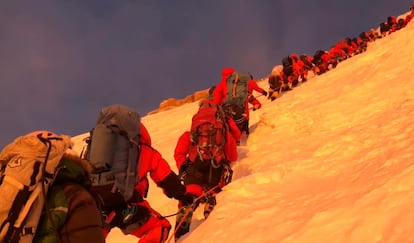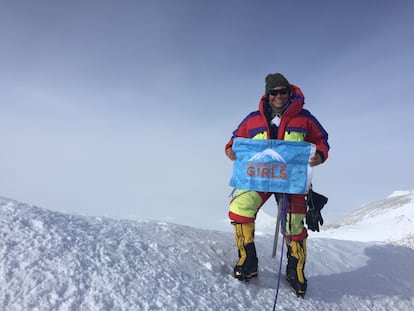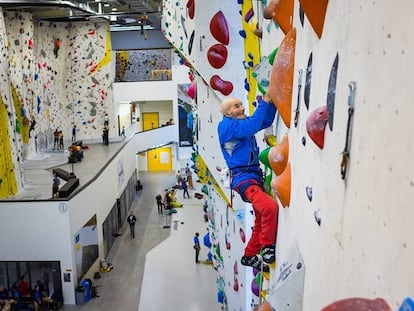Traffic jams on K2 peak: 145 climbers reach the top in a single day
The Everest business model is being replicated on the world’s second-highest and riskiest mountain, once the exclusive domain of elite mountaineers

With all due respect to their respective sizes, Everest (8.848 m) is no more a mountain than K2 (8.611 m). The latter, located in the Karakoram Range, has a perilous section known as the Bottleneck, which has fueled the nightmares of mountaineers since it was first summited in 1954. Until fairly recently, only pedigreed climbers tackled K2. The rest lined up for the far more accessible Everest. And that’s why, as of February 2021, according to the Himalayan Database’s count, Everest had 10,658 confirmed summits and K2 just 377.
But something has changed. This summer, climbers have been lining up to summit the second-highest mountain on the planet. As a result, in a single recent day, 145 people reached the peak–as many as had achieved it between 1954 and 1996. And the mountaineers lined up in the worst possible place: a narrow, vertical passage below a hanging serac, a giant glacier that could collapse at any moment. It’s like standing in line to buy bread from a burning building. The Bottleneck has always posed a huge risk, like a sword of Damocles. There have been avalanches and massive ice collapses in this area. Mountaineers celebrating their summit have had their ropes severed, trapping them on their descent. With the Bottleneck area jammed with aspirants, such an accident would be grotesque. In a video, Sherpa mountaineer Mingma G denounced the situation with images from July 22, the day that 145 people reached K2′s peak.
In January 2021, a team of 10 Nepalese climbers made history by completing the first-ever winter ascent of K2. Nirmal Purja and Mingma G’s teams joined forces. They looked not only to leave a mark on the history of Himalayanism, but also to expand their business. Both have since climbed K2 again, now leading a good number of clients by the hand. On social media, Nirmal Purja, the man who amazed the mountaineering community by climbing the 14 eight-thousanders of the globe in just over six months, brags that he took 33 of his clients to the top on the same day.
Their work had traditionally been restricted to leading expeditions to eight-thousanders in spring and autumn. The Nepalese wanted to find new sources of income, especially in summer when monsoons make it impossible to get close to Nepal’s highest mountains. Opening their line of business to the five eight-thousanders located in Pakistan seemed like the best idea. The clients scaled the K2 with ease, reaching its top in a group. The extreme feat now seemed simple. Now the guides have copied the Everest strategy, employing huge amounts of material and highly qualified Sherpa workers to guarantee fixed ropes to the top and, especially, at the Bottleneck. In a show of efficiency, the Sherpas placed a rope line for ascent and another for descent to prevent traffic jams from causing accidents.
Now, local companies, Nepalese agencies and Western guides are all working on K2. What was previously considered a mountain for climbers, a refuge for only the most autonomous and committed mountaineers, became, in just a year, a copy of Everest. Commercial interests, weather forecasts, kilometers of fixed ropes, hundreds of oxygen bottles and a large number of Sherpas from Nepal have made scaling the K2 accessible to the masses.
The wave of aspiring summiters, estimated at around 400 people, fits poorly into a mountain with few locations for high-altitude camps. Several climbers have reported fights to secure place in fields 1 and 2. They have taken turns using the tents on site during the acclimatization phase. The terrain is too steep to accommodate them all. Mingma G himself was also concerned about the heat in the area–just -17ºC registered at the top. The consequent rockfall on the route has already caused injuries to three workers. Days before the viral video recorded on July 22, many hopefuls reached Camp 4, at about 8,000 meters, to be in the front line and start the race when the fixed ropes were installed.
Currently, three fatal accidents have been unofficially registered, none of them in the Bottleneck area. And it’s worth remembering that, while in Nepal private helicopters fly to extract mountaineers from Everest and other eight-thousanders, in Pakistan, such flights are carried out by the army, only under orders of the military command.
Tu suscripción se está usando en otro dispositivo
¿Quieres añadir otro usuario a tu suscripción?
Si continúas leyendo en este dispositivo, no se podrá leer en el otro.
FlechaTu suscripción se está usando en otro dispositivo y solo puedes acceder a EL PAÍS desde un dispositivo a la vez.
Si quieres compartir tu cuenta, cambia tu suscripción a la modalidad Premium, así podrás añadir otro usuario. Cada uno accederá con su propia cuenta de email, lo que os permitirá personalizar vuestra experiencia en EL PAÍS.
¿Tienes una suscripción de empresa? Accede aquí para contratar más cuentas.
En el caso de no saber quién está usando tu cuenta, te recomendamos cambiar tu contraseña aquí.
Si decides continuar compartiendo tu cuenta, este mensaje se mostrará en tu dispositivo y en el de la otra persona que está usando tu cuenta de forma indefinida, afectando a tu experiencia de lectura. Puedes consultar aquí los términos y condiciones de la suscripción digital.
More information
Últimas noticias
Welcome to the post-religion era: The idea of Christianity as the absolute truth has become obsolete
‘I thought you would like it’: The risky sexual practice popularized by TV shows and TikTok
The digitalization of tourism: ‘They promise experiences and gave us the worst possible one’
Mexican peso defies uncertainty with forecasts of a new period of stability in 2026
Most viewed
- Sinaloa Cartel war is taking its toll on Los Chapitos
- Reinhard Genzel, Nobel laureate in physics: ‘One-minute videos will never give you the truth’
- Oona Chaplin: ‘I told James Cameron that I was living in a treehouse and starting a permaculture project with a friend’
- Why the price of coffee has skyrocketed: from Brazilian plantations to specialty coffee houses
- Silver prices are going crazy: This is what’s fueling the rally











































